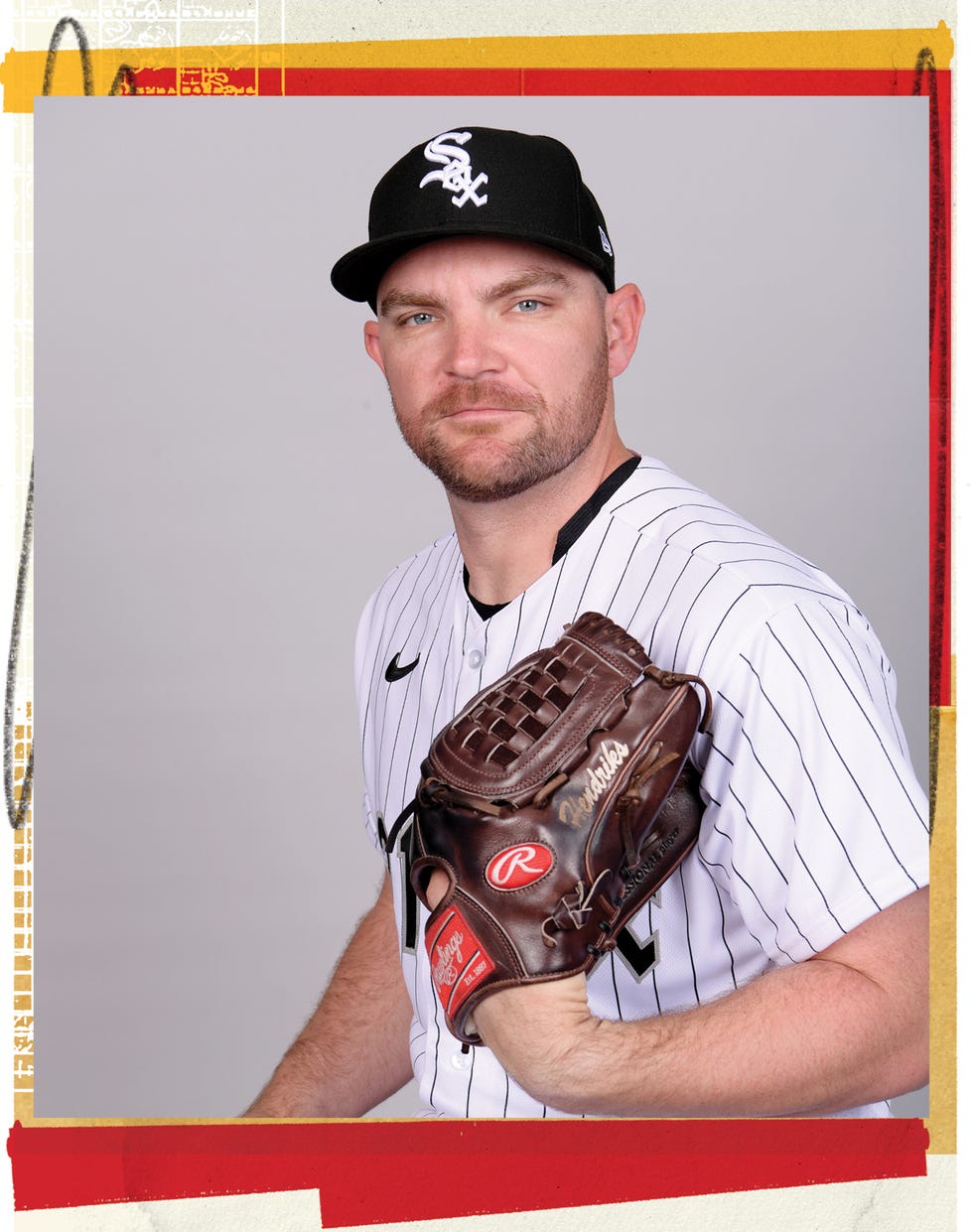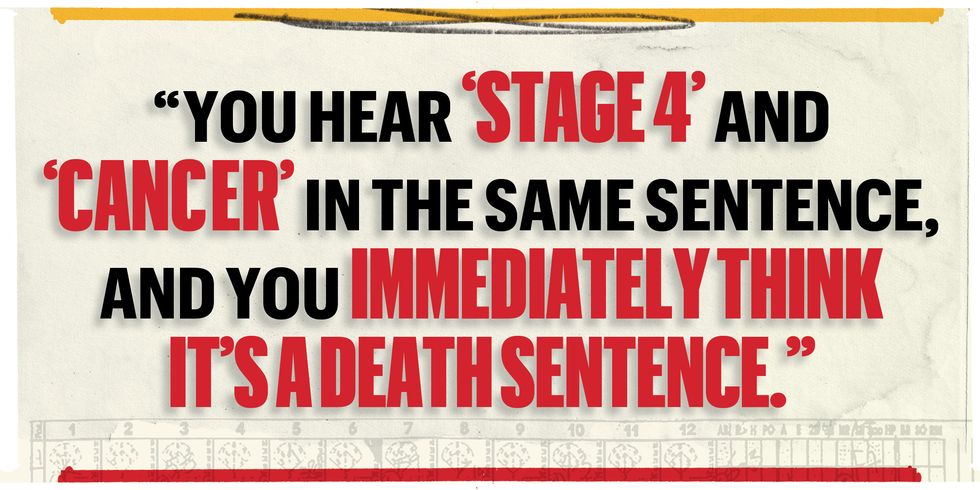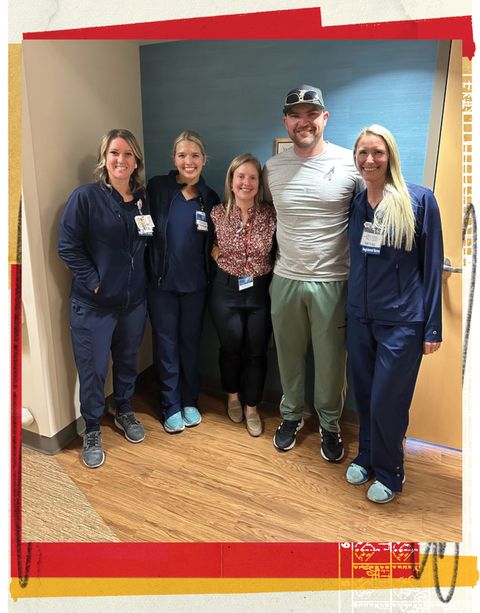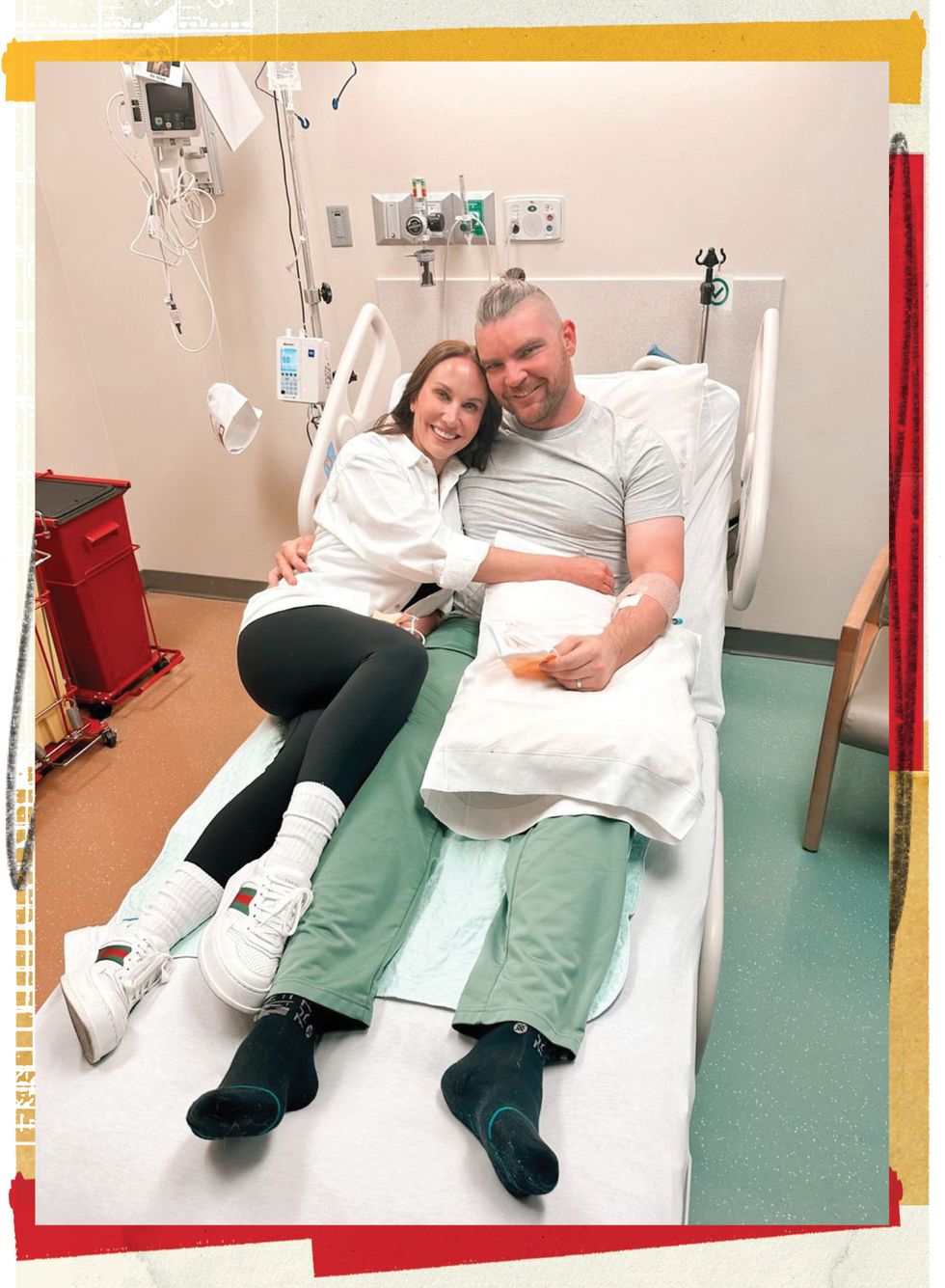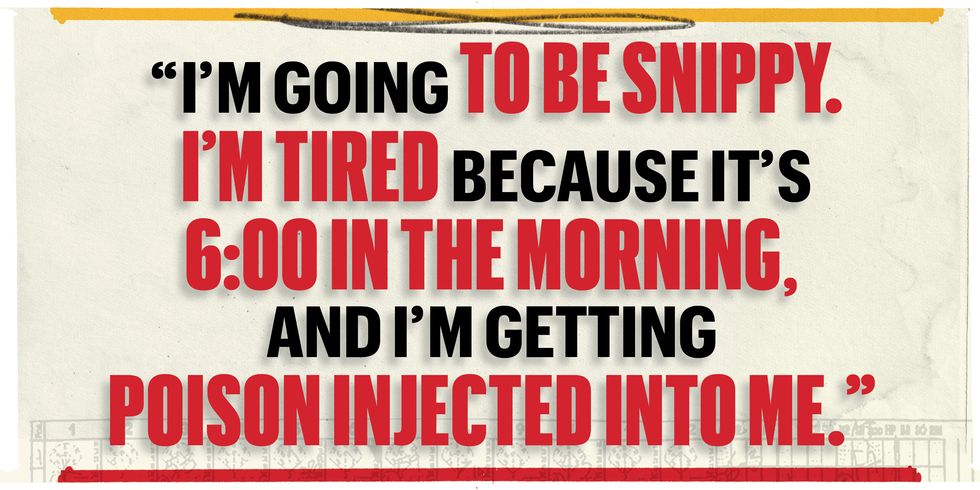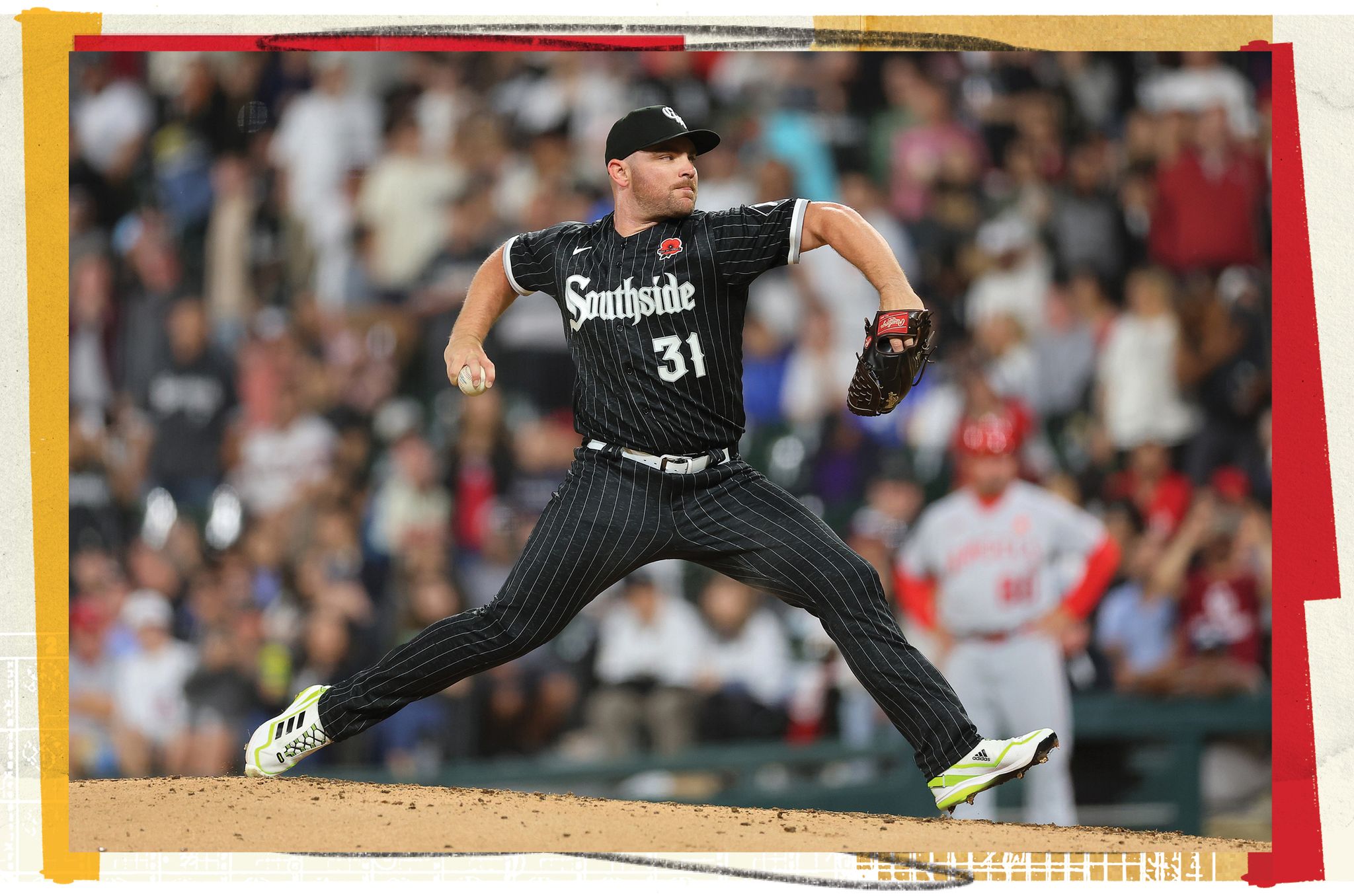[ad_1]
“IT’S STAGE FOUR, but I’m not worried.”
When Liam Hendriks, the fiery and self-proclaimed “very Australian” All-Star closer for the Chicago White Sox, heard that roller coaster of a sentence come from the mouth of the Mayo Clinic’s Dr. Allison Rosenthal, D.O., last December, he did a double take.
He knew something was wrong, of course. It had been nearly six months since Hendriks rubbed the side of his face while on the mound during a mid-June game, and noticed a series of small lumps along his jawline that continued around to the back of his head. After that game, he applied a hot compress, the first of many in the weeks to come, but the swollen nodules never went down. If anything, they were growing.
After the Sox missed the 2022 playoffs, he began a series of doctor appointments, which ultimately led to a biopsy and the totally unexpected diagnosis: He had cancer, specifically lymphoma. So Hendriks sought out a specialist, Dr. Rosenthal, who is a board-certified hematologist and oncologist, to figure out exactly how dire his condition looked.
The answer: Pretty dire. “You hear ‘stage 4’ and ‘cancer’ in the same sentence, and you immediately think it’s a death sentence,” Hendriks says in early June, while drinking coffee beside his wife, Kristi, in a dimly lit lounge in the back of a fancy hotel in midtown Manhattan.
But once Hendriks finally got the official diagnosis from Dr. Rosenthal, he says he felt oddly settled because it was clear that she had a survival plan. “That was a huge relief,” he says about finally knowing what he was up against. “I never really wavered in my positivity towards it all because there’s no point.”
Hendriks had his own plan, too, of course—one that would turn out to be even more ambitious. He not only wanted to beat cancer, but do it fast enough to rejoin his team for the 2023 season.
That might sound like an absurd goal, but on the day we talked, June 5th, six months after his diagnosis, it was his first week back in the big leagues. The next day, he would wind up taking the mound against the New York Yankees for the chance at potentially notching his first-ever post-cancer save. “It’s going to be something special,” he says about what that upcoming opportunity—potentially slamming the door shut on a close game, what an MLB closer lives for—might mean. He pauses for a moment, seeming to process the reality that this can happen again, and repeats himself. “It’s going to be something special.”
But Hendriks, 34, a journeyman pitcher who has played for five different big league teams, has already developed a reputation for being utterly driven—if far more expletive-loving and uncensored in the midst of games. After years of bouncing around the MLB, he totally transformed his game in 2019 as a member of the Oakland Athletics, his strikeout rate skyrocketing and eventually earning his first chance to close games. He’s since signed a major contract—three years and $54 million—with the White Sox, and been named the American League’s Reliever of the Year twice. He’s known for his hard fastball—which generally sits around 95 miles-per-hour—and animated antics and persona on the mound. (As anyone who remembers the semi-viral video of his time miked up at the 2021 MLB All Star game might recall, Hendriks swears profusely after throwing bad pitches—it’s almost like that’s his automatic reset button.)
In classic Liam Hendriks fashion, he seems to have relished the idea of setting the hard goal of a sports comeback amid an especially challenging medical crisis. “There was never any doubt that I was returning this season,” Hendriks says without a shred of hesitation. “That was never a doubt.”
DR. ROSENTHAL IS a Chicago native, former collegiate gymnast, and Leukemia survivor, so she and Hendriks had an instant connection. But she wanted to tell the White Sox star something important right up front: She was a baseball fan, but grew up rooting for Chicago’s other team, the Cubs.
“He very quickly said, it’s no problem. You could be a Liam fan,” she recalls, laughing a bit. “We’ve converted other people.”
That conversion didn’t take long. Right up front, Dr. Rosenthal says she was impressed by Hendriks’s goal to play Major League Baseball in 2023. She also wanted him to remain realistic; his health needed to come first. That meant enduring a two-pronged attack against the lymphoma that involved two days of hospital visits each month or so: Every three to four weeks, he’d go in to start a round of immunotherapy, an intravenous therapy that strengthened his immune system. That same day, he’d also undergo chemotherapy, followed by yet another dose of chemo the following day. There was no telling how his body might react to each round, but the process could take up to six rounds to be successful.
“I know what it’s like to be a competitive athlete and push yourself to the limits all the time,” Dr. Rosenthal recalls telling Hendriks. “Don’t do that. Don’t ask your body to do more than it’s capable of when we’re stressing it in another way. But please do the things you love.”
Beyond that, Dr. Rosenthal didn’t put a ton of guardrails on what Hendriks should or shouldn’t do because his goal was apparent to anyone in his path. In fact, Hendriks started telling everyone he could about his plan to return to baseball quickly. Shortly after his diagnosis, he called his boss, White Sox General Manager Rick Hahn. It’s “fairly atypical,” as Hahn puts it, to get a call from any player in the middle of the offseason. But when Hendriks got on the phone with Hahn, he was all business. “Here’s what’s going on and here’s how I’m going to beat it. Here’s when I’m going to be back,” Hahn says, recalling their phone conversation.
Early on, though, things looked far from certain. On Monday, January 9th, 2023, the day after he revealed his diagnosis on Instagram, Liam Hendriks started his first immunotherapy and chemotherapy session. “I just didn’t know what to expect,” he says. While usually unflinching and sure of himself, Kristi says that her husband would not stop talking during their early morning drive to the hospital. “Anytime Liam is Chatty Cathy, as I like to call him, you know he’s nervous,” she says.
They started around 6 AM with the intravenous drip being administered slowly to make sure everything was flowing correctly. After the first 30 minutes, the hospital staff increased his dosage and Hendriks didn’t react well. He remembers withering in pain, vomiting, and feeling clammy and cold at the same time while his wife rubbed his back to comfort him.
Hendriks is no stranger to discomfort. In 2008, at age 19, he had a back surgery that cost him an entire minor league season. Seven years later, in 2015, he had a flare up from autoimmune hepatitis, a liver condition that he actively manages, which caused enough pain that he’s since quit drinking alcohol. When he missed some playing time with a forearm issue last year, it was revealed that he’d been playing for years with a torn ulnar collateral ligament in his arm. (The injury generally requires pitchers to sit out an entire season.)
But this was different. Chemotherapy works because the treatment seeks out and destroys cancer cells, but it also poisons your body—so you have to endure extreme sickness, again and again, in order to hopefully get healthier. “I’ve seen him be incredibly sick before,” says Kristi. “That was unlike anything I’d ever experienced.”
Ten hours after their first session, Kristi drove Liam home. He felt both exhausted and daunted by the idea of coming back for more the next day. Through the first couple of rounds, these Mondays, Hendriks would eventually say, turned out to be the “hard day” because he’d be at the hospital between 9 and 12 hours. Tuesdays were the “easy day” because the treatment time for his second dose of chemotherapy alone ranged from 90 to 120 minutes. (Eventually, the rounds went even quicker because he proved resilient enough for a process called rapid-infusion therapy.)
The hospital staff remained the same for every trip, and Hendriks says that he and Kristi appreciated their kindness, even when he wasn’t at his best. “I’m going to be snippy,” he says about how he felt some days. “I’m tired because it’s six in the morning, and I’m getting poison injected into me.”
While Hendriks was “catatonic” on the couch on the Wednesdays and Thursdays following his treatments, he still set himself a goal. Three days later, on Fridays, he would head back to the ballpark. That’s right—poison flowing through his veins wasn’t going to stop Liam Hendriks from at least throwing the ball. In fact, he never stopped practicing—even at the peak of his treatment cycle, he was at the very least having a soft toss a couple times per week.
As he saw it, this lined up with the practical advice for people undergoing chemo, which is to drink lots of water, create a routine, and try to exercise a bit. Throwing a baseball around in a stadium was his exercise, and getting out of the house to the ballpark was his routine.
Along the way, Hendriks heard from other players, including Cubs pitcher Jameson Taillon, who has beaten testicular cancer. Taillon relayed a message that he got from former Colorado Rockies pitcher Chad Bettis, also a testicular cancer survivor, which Hendriks has now adopted. “No one can tell you how you’re going to feel,” Hendriks repeats. “Do what you feel is right. Everybody’s walk is different.”
For Hendriks, this meant continuing to push himself beyond what he deemed his initial limits. At first, “just” playing pro-level catch was his version of taking it easy—something he says he’d never done before in his career. He didn’t reinvent himself as one of the league’s best by taking it easy. “It’s always been about trying to push something a little further,” he says. After his conversation with Taillon in late January, he decided to throw his first bullpen session. “I’m going to make sure that as soon as I get that medical clearance, I am ready to go,” he says about his mentality at the time.
Dr. Rosenthal kept an eye on his on-field progression. “I think the medical staff on the team might have been a little surprised at first when I said, No, he can do those things,” she says. “We actually have good data that for people who have non-Hodgkin’s Lymphoma, as Liam does, those that are more physically active have better survival. We have data that backs up the fact that people shouldn’t just sit around and do nothing. This was an extreme. This was a different type of activity, maybe, than that pertains to, but there was no reason to keep him from doing what he loved, as long as he felt up to it.”
At the same time, Hendriks’s teammates were in awe. Jake Burger, who plays third base for the White Sox, remembers seeing him show up at the ballpark while he was recovering. “You see a guy going through what he’s going through and he’s still coming in trying to compete for the team,” he says. “That’s a guy that I want in my clubhouse, and a guy I want to play with always. ‘I’ve got to take care of my health, but I’ve got a job to do when I beat this thing’—that was his motto the entire time.”
White Sox shortstop Tim Anderson wasn’t even sure whether Hendriks was actually supposed to be at the park at all—but didn’t want to ask any questions as to make things seem out of the ordinary. “I wanted to keep it as normal as I could and not really make it a sad story, because I knew he was going to overcome it,” Anderson says. “It’s just the type of competitor he is.”
After three months of treatment, on March 27, 2023, Hendriks underwent a routine PET scan, an imaging test used to check for cancerous cells and growths. He had an appointment about 90 minutes later to go over the results with Dr. Rosenthal, so he and his wife had just hopped in the car to grab a quick coffee when they got a text. “The scan looks amazing,” Dr. Rosenthal wrote. “Everything looks great.”
Time, at that point, started to slow down. Hendriks knew it was good news, but didn’t know how that would affect his treatment. “What does great necessarily mean?” he asks. “Does great mean four rounds? Does great mean six rounds? We didn’t know.” The wait to go over the scan felt brutal. Thankfully, Dr. Rosenthal was able to get to the hospital earlier than planned and let them know what was going on: There would likely only need to be one more round. Two weeks after the conclusion of Round 4, they’d take a bone marrow biopsy to determine if there were any more cancerous cells in his body. If the test showed that he was clear, he could attempt to make his return to baseball.
On April 18, Hendriks went for the bone marrow biopsy that Dr. Rosenthal had suggested, and after three long days, the results came back: Liam Hendriks was in the clear. Before returning, he was sent down to the minors for a rehabilitation assignment, playing for the White Sox AAA team, North Carolina’s Charlotte Knights, while he regained his strength. But Hendriks progressed quickly—returning to the White Sox active roster by late May.
And it was clear he was back to being his old self, too. “When you walk in the room, you never know what you may get,” Anderson added when asked about his impression of his energetic, profanity-loving teammate just hours before Hendriks’s potential save opportunity against the Yankees, and then began to smirk. “You may get a, ‘Hey,’ or you may get… something else.”
LIAM HENDRIKS MADE his official return to Major League Baseball at home at Chicago’s Guaranteed Rate Field on May 29, 2023. When he came into the game with the White Sox trailing the Angels 4-3 in the 8thinning, the game completely stopped as the hometown crowd stood and gave him a thunderous ovation. The Angels hitter due up, Matt Thaiss, stepped out of the box. The umpire, John Libka, allowed the newly-instated pitch clock to lapse without penalty.
This was going to be a big moment, and nothing was going to get in its way. By the time Hendriks got to the mound, he had no grand gesture, no animated celebration, no wave to the crowd that you may have expected. He just smiled ever so slightly, looked around, and took it all in.
“I wasn’t prepared for that. That was really emotional, because it was…” he says, pausing to collect his thoughts and remember what he describes as the surreal nature of the scene. “Yeah, that one was tough. I didn’t expect it, and I didn’t have anything to focus on. It was thinking about what I’ve been through.”
The gravity of that moment wasn’t lost on Hendriks, who requested to have the ball from that first at-bat taken out of the game and saved for his ever-expanding personal collection. After the game, he sent a courtesy bottle of whiskey to Thaiss; Libka, the umpire, couldn’t get a gift “because I think that goes as acting like a bribe,” Hendriks says. But the gesture unquestionably was appreciated.
“It’s just beyond baseball,” says White Sox manager Pedro Griffol. “When you have someone that you’re close to and a part of the team like he is, it’s just an inspiration.”
Andrew Vaughn, a first baseman for the White Sox, remembers seeing the entire stadium, including everyone in the visitors dugout, standing on their feet in universal support of his teammate. “It’s something that you don’t like to say he deserved,” he says, making it clear that no one should have to go through cancer. “But he deserved it,” he says about the ovation.
It was just one week later when Hendriks took the mound at Yankee Stadium during what turned out to be a somewhat eerie night game. The air was boggy and smelled acrid with everything cast in a sepia-like haze as smoke from the wildfires still raging up in Canada rolled over the city.
Hendriks entered the game with the White Sox leading the Yankees 3-1 in the bottom of the 9th inning. He immediately gave up a leadoff home run, but didn’t seem concerned. Instead of panicking, he blew his fastball over the plate like it was any other day at the ballpark, and got three straight ground ball outs to close the game. This might have been his first post-cancer save, but he handled it like business as usual.
“Every outing, I’ve gotten a little bit stronger. Every outing, I’ve got my legs under me a little bit more,” he says. “There’s no substitute for that adrenaline.”
Since that game, Hendriks has developed an unrelated elbow issue, but his return this July remains probable, and it may be just in time to help the White Sox get over the hump just in time for a second-half run.
Whatever happens, odds are Hendriks won’t be worried. He’s got plenty of experience not being worried about far bigger things. And that’s not about to change now.

Evan is the culture editor for Men’s Health, with bylines in The New York Times, MTV News, Brooklyn Magazine, and VICE. He loves weird movies, watches too much TV, and listens to music more often than he doesn’t.
[ad_2]

